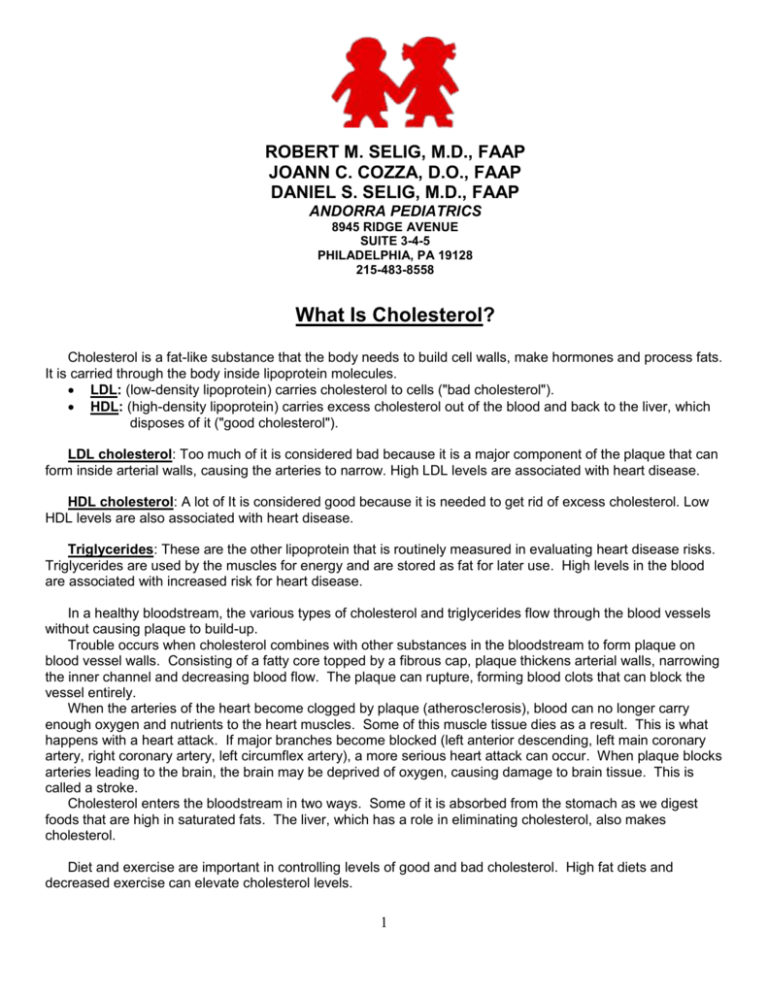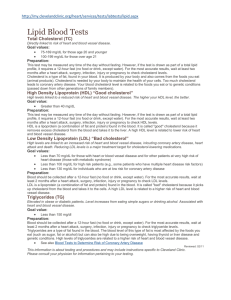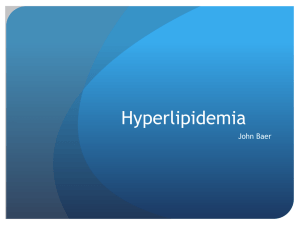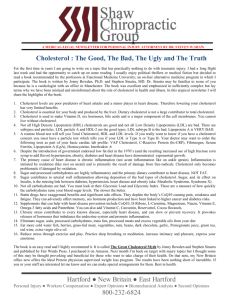Word Version - Andorra Pediatrics
advertisement

ROBERT M. SELIG, M.D., FAAP JOANN C. COZZA, D.O., FAAP DANIEL S. SELIG, M.D., FAAP ANDORRA PEDIATRICS 8945 RIDGE AVENUE SUITE 3-4-5 PHILADELPHIA, PA 19128 215-483-8558 What Is Cholesterol? Cholesterol is a fat-like substance that the body needs to build cell walls, make hormones and process fats. It is carried through the body inside lipoprotein molecules. LDL: (low-density lipoprotein) carries cholesterol to cells ("bad cholesterol"). HDL: (high-density lipoprotein) carries excess cholesterol out of the blood and back to the liver, which disposes of it ("good cholesterol"). LDL cholesterol: Too much of it is considered bad because it is a major component of the plaque that can form inside arterial walls, causing the arteries to narrow. High LDL levels are associated with heart disease. HDL cholesterol: A lot of It is considered good because it is needed to get rid of excess cholesterol. Low HDL levels are also associated with heart disease. Triglycerides: These are the other lipoprotein that is routinely measured in evaluating heart disease risks. Triglycerides are used by the muscles for energy and are stored as fat for later use. High levels in the blood are associated with increased risk for heart disease. In a healthy bloodstream, the various types of cholesterol and triglycerides flow through the blood vessels without causing plaque to build-up. Trouble occurs when cholesterol combines with other substances in the bloodstream to form plaque on blood vessel walls. Consisting of a fatty core topped by a fibrous cap, plaque thickens arterial walls, narrowing the inner channel and decreasing blood flow. The plaque can rupture, forming blood clots that can block the vessel entirely. When the arteries of the heart become clogged by plaque (atherosc!erosis), blood can no longer carry enough oxygen and nutrients to the heart muscles. Some of this muscle tissue dies as a result. This is what happens with a heart attack. If major branches become blocked (left anterior descending, left main coronary artery, right coronary artery, left circumflex artery), a more serious heart attack can occur. When plaque blocks arteries leading to the brain, the brain may be deprived of oxygen, causing damage to brain tissue. This is called a stroke. Cholesterol enters the bloodstream in two ways. Some of it is absorbed from the stomach as we digest foods that are high in saturated fats. The liver, which has a role in eliminating cholesterol, also makes cholesterol. Diet and exercise are important in controlling levels of good and bad cholesterol. High fat diets and decreased exercise can elevate cholesterol levels. 1 Parents with high cholesterol levels may pass a gene to their children that will cause elevated cholesterol levels in their children. What Are Normal Cholesterol and Triglyceride Levels? The desirable, borderline, and high levels of lipids in your bloodstream are shown below. All figures are in mg/dL (milligrams per deciliter of blood). Acceptable Borderline High Total Cholesterol Less than 170 171-199 Over 200 LDL Below 110 110-129 Over 130 HDL 35 or higher Triglycerides Less than 150 Below 35 151-400 Over 400 Facts About Cholesterol Fasting does not affect cholesterol levels. It will only affect triglyceride levels. A high fat meal will raise your triglyceride level. Triglyceride levels are used to determine your LDL level. The higher the triglyceride level, the higher your LDL level. A high triglyceride level right after a high fat meal may not be representative of your true triglyceride and LDL levels. 7. Cholesterol levels done by finger stick may sometimes be higher than when drawn from a vein in your arm (unknown reason). 8. If a cholesterol level is found to be over 200, it is necessary to have a full cholesterol panel done by taking blood from your child’s arm. The cholesterol panel includes: total cholesterol and triglycerides, HDL and LDL, apolipoproteins A & B (carrier proteins for LDL cholesterol), and thyroid tests. 1. 2. 3. 4. 5. 6. Treatment Of Elevated Cholesterol In Children The purpose for checking cholesterol levels in children is to determine those children who may be at a higher risk for heart disease in the future. A high cholesterol as a child is not an immediate problem. Formation of cholesterol plaques begins during childhood and usually does not cause significant narrowing of the blood vessels until adulthood. The following is recommended for children found to have elevated cholesterol levels: Step I & Step II diets: low fat-low cholesterol foods (we have a handout outlining these diets) Increase exercise: helps raise HDL and lower LDL. Cholesterol tests done every 1-2 years. Have parents and other siblings check their cholesterol levels. Cholesterol lowering medicines used in adults are not recommended for children until after 10 years of age. 2








